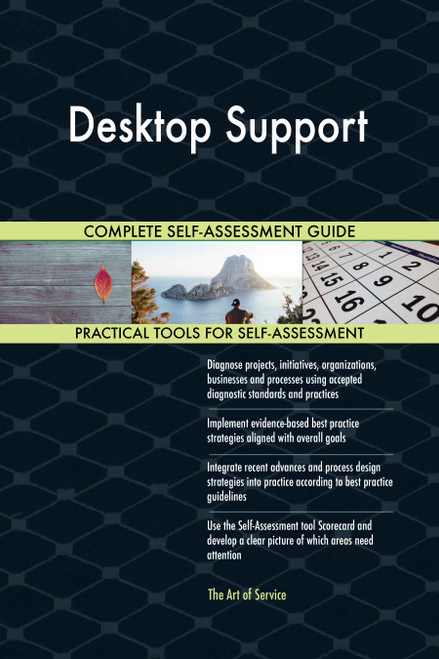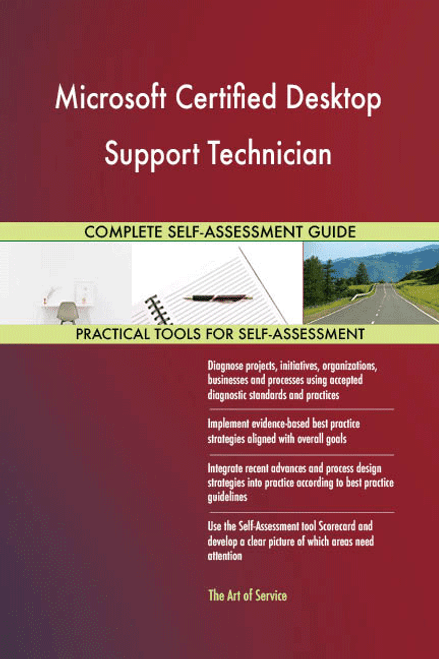Be certain that your organization provides leadership in planning and managing computer operations and production support, systems and Database Administration, Network Operations, security, applications maintenance and support, telecommunications, PC/ Desktop Support, and the Customer Service center.
More Uses of the Desktop Support Toolkit:
- Install software and simple Desktop Support for Finance.
- Look to improve all aspects of the Desktop Support functions continually.
- Coordinate with Desktop Support to resolve passive optical network issues, document issues and work performed in incident report workflow log.
- Provide Desktop Support to staff relating to computers and technology.
- Head: work in partnership with the Desktop Support area, understands and follows the established technology standards and support processes as appropriate.
- Keep current on industry support tools and standards that are in alignment with Desktop Support functions.
- Collaborate with Desktop Support to address issues or develop installation procedures.
- Devise: Desktop Support technicians Help Desk technology services.
- Provide Desktop Support services to the government user community.
- Control: system management and Desktop Support while ensuring your organizations technology fully.
- Manage: plan and address Desktop Support staffing needs to deliver consistent IT support.
- Represent the interests of your customers by providing support and appropriate escalation to Desktop Support Site Leads and other IT functions when issues cannot be resolved.
- Provide technical Desktop Support via remote connection tools and on site.
- Coordinate and collaborate with Network Engineering, business application, Database Administration, and Desktop Support functions to ensure availability, reliability, and scalability of corporate servers to meet business demands.
- Make sure that your organization handles problems that the first level of Desktop Support is unable to resolve.
- Initiate: work closely with Desktop Support Technicians to ensure that all provisioned assets are properly tracked and accounted for.
- Establish and measure IT performance relative to cost, value creation and Customer Satisfaction in the key areas of operating systems, telecommunications, Network Management and Desktop Support.
- Follow helpdesk/Desktop Support best practices (ITIL centric) to ensure accurate, timely Problem Resolution.
- Establish: backup the System Administration in daily critical tasks related to things as system backups, error monitoring, and occasional Desktop Support.
- Support desk, hardware and software Asset Management, and Desktop Support.
- Provide oversight of the Application Development, Desktop Support, and project execution teams.
- Support the utilization of device management tools by Desktop Support Technicians through defined SOPs and trainings.
- Confirm your team ensures it maintains the infrastructure, network, key critical clinical and non clinical applications, Desktop Support and proper Disaster Recovery procedures.
- Develop and implement Desktop Support policies, processes, and procedures.
- Audit: trouble shoot technology related problems at the end user level and provide Desktop Support of networked computers.
- Ensure you gain; lead business and technical application, IT infrastructure, Security And Compliance, Desktop Support, database maintenance etc.
- Manage: monitor the Desktop Support queue and help maintain the SLA guidelines set.
- Warrant that your project maintains technical expertise in Desktop Support technology.
- Evaluate: interface with IT vendors and suppliers related to end user Desktop Support, procuring IT equipment and maintaining related processes.
- Provide Desktop Support for hardware, software, network, A/V, system performance and security issues.
Save time, empower your teams and effectively upgrade your processes with access to this practical Desktop Support Toolkit and guide. Address common challenges with best-practice templates, step-by-step Work Plans and maturity diagnostics for any Desktop Support related project.
Download the Toolkit and in Three Steps you will be guided from idea to implementation results.
The Toolkit contains the following practical and powerful enablers with new and updated Desktop Support specific requirements:
STEP 1: Get your bearings
Start with...
- The latest quick edition of the Desktop Support Self Assessment book in PDF containing 49 requirements to perform a quickscan, get an overview and share with stakeholders.
Organized in a Data Driven improvement cycle RDMAICS (Recognize, Define, Measure, Analyze, Improve, Control and Sustain), check the…
- Example pre-filled Self-Assessment Excel Dashboard to get familiar with results generation
Then find your goals...
STEP 2: Set concrete goals, tasks, dates and numbers you can track
Featuring 999 new and updated case-based questions, organized into seven core areas of Process Design, this Self-Assessment will help you identify areas in which Desktop Support improvements can be made.
Examples; 10 of the 999 standard requirements:
- Are there competing Desktop Support priorities?
- What scope do you want your strategy to cover?
- How do you go about comparing Desktop Support approaches/solutions?
- Is a Desktop Support breakthrough on the horizon?
- Do you have past Desktop Support successes?
- Why are you doing Desktop Support and what is the scope?
- Is it clearly defined in and to your organization what you do?
- Who qualifies to gain access to data?
- How is data used for Program Management and improvement?
- Which issues are too important to ignore?
Complete the self assessment, on your own or with a team in a workshop setting. Use the workbook together with the self assessment requirements spreadsheet:
- The workbook is the latest in-depth complete edition of the Desktop Support book in PDF containing 994 requirements, which criteria correspond to the criteria in...
Your Desktop Support self-assessment dashboard which gives you your dynamically prioritized projects-ready tool and shows your organization exactly what to do next:
- The Self-Assessment Excel Dashboard; with the Desktop Support Self-Assessment and Scorecard you will develop a clear picture of which Desktop Support areas need attention, which requirements you should focus on and who will be responsible for them:
- Shows your organization instant insight in areas for improvement: Auto generates reports, radar chart for maturity assessment, insights per process and participant and bespoke, ready to use, RACI Matrix
- Gives you a professional Dashboard to guide and perform a thorough Desktop Support Self-Assessment
- Is secure: Ensures offline Data Protection of your Self-Assessment results
- Dynamically prioritized projects-ready RACI Matrix shows your organization exactly what to do next:
STEP 3: Implement, Track, follow up and revise strategy
The outcomes of STEP 2, the self assessment, are the inputs for STEP 3; Start and manage Desktop Support projects with the 62 implementation resources:
- 62 step-by-step Desktop Support Project Management Form Templates covering over 1500 Desktop Support project requirements and success criteria:
Examples; 10 of the check box criteria:
- Cost Management Plan: Eac -estimate at completion, what is the total job expected to cost?
- Activity Cost Estimates: In which phase of the Acquisition Process cycle does source qualifications reside?
- Project Scope Statement: Will all Desktop Support project issues be unconditionally tracked through the Issue Resolution process?
- Closing Process Group: Did the Desktop Support project team have enough people to execute the Desktop Support project plan?
- Source Selection Criteria: What are the guidelines regarding award without considerations?
- Scope Management Plan: Are Corrective Actions taken when actual results are substantially different from detailed Desktop Support project plan (variances)?
- Initiating Process Group: During which stage of Risk planning are risks prioritized based on probability and impact?
- Cost Management Plan: Is your organization certified as a supplier, wholesaler, regular dealer, or manufacturer of corresponding products/supplies?
- Procurement Audit: Was a formal review of tenders received undertaken?
- Activity Cost Estimates: What procedures are put in place regarding bidding and cost comparisons, if any?
Step-by-step and complete Desktop Support Project Management Forms and Templates including check box criteria and templates.
1.0 Initiating Process Group:
- 1.1 Desktop Support project Charter
- 1.2 Stakeholder Register
- 1.3 Stakeholder Analysis Matrix
2.0 Planning Process Group:
- 2.1 Desktop Support Project Management Plan
- 2.2 Scope Management Plan
- 2.3 Requirements Management Plan
- 2.4 Requirements Documentation
- 2.5 Requirements Traceability Matrix
- 2.6 Desktop Support project Scope Statement
- 2.7 Assumption and Constraint Log
- 2.8 Work Breakdown Structure
- 2.9 WBS Dictionary
- 2.10 Schedule Management Plan
- 2.11 Activity List
- 2.12 Activity Attributes
- 2.13 Milestone List
- 2.14 Network Diagram
- 2.15 Activity Resource Requirements
- 2.16 Resource Breakdown Structure
- 2.17 Activity Duration Estimates
- 2.18 Duration Estimating Worksheet
- 2.19 Desktop Support project Schedule
- 2.20 Cost Management Plan
- 2.21 Activity Cost Estimates
- 2.22 Cost Estimating Worksheet
- 2.23 Cost Baseline
- 2.24 Quality Management Plan
- 2.25 Quality Metrics
- 2.26 Process Improvement Plan
- 2.27 Responsibility Assignment Matrix
- 2.28 Roles and Responsibilities
- 2.29 Human Resource Management Plan
- 2.30 Communications Management Plan
- 2.31 Risk Management Plan
- 2.32 Risk Register
- 2.33 Probability and Impact Assessment
- 2.34 Probability and Impact Matrix
- 2.35 Risk Data Sheet
- 2.36 Procurement Management Plan
- 2.37 Source Selection Criteria
- 2.38 Stakeholder Management Plan
- 2.39 Change Management Plan
3.0 Executing Process Group:
- 3.1 Team Member Status Report
- 3.2 Change Request
- 3.3 Change Log
- 3.4 Decision Log
- 3.5 Quality Audit
- 3.6 Team Directory
- 3.7 Team Operating Agreement
- 3.8 Team Performance Assessment
- 3.9 Team Member Performance Assessment
- 3.10 Issue Log
4.0 Monitoring and Controlling Process Group:
- 4.1 Desktop Support project Performance Report
- 4.2 Variance Analysis
- 4.3 Earned Value Status
- 4.4 Risk Audit
- 4.5 Contractor Status Report
- 4.6 Formal Acceptance
5.0 Closing Process Group:
- 5.1 Procurement Audit
- 5.2 Contract Close-Out
- 5.3 Desktop Support project or Phase Close-Out
- 5.4 Lessons Learned
Results
With this Three Step process you will have all the tools you need for any Desktop Support project with this in-depth Desktop Support Toolkit.
In using the Toolkit you will be better able to:
- Diagnose Desktop Support projects, initiatives, organizations, businesses and processes using accepted diagnostic standards and practices
- Implement evidence-based best practice strategies aligned with overall goals
- Integrate recent advances in Desktop Support and put Process Design strategies into practice according to best practice guidelines
Defining, designing, creating, and implementing a process to solve a business challenge or meet a business objective is the most valuable role; In EVERY company, organization and department.
Unless you are talking a one-time, single-use project within a business, there should be a process. Whether that process is managed and implemented by humans, AI, or a combination of the two, it needs to be designed by someone with a complex enough perspective to ask the right questions. Someone capable of asking the right questions and step back and say, 'What are we really trying to accomplish here? And is there a different way to look at it?'
This Toolkit empowers people to do just that - whether their title is entrepreneur, manager, consultant, (Vice-)President, CxO etc... - they are the people who rule the future. They are the person who asks the right questions to make Desktop Support investments work better.
This Desktop Support All-Inclusive Toolkit enables You to be that person.
Includes lifetime updates
Every self assessment comes with Lifetime Updates and Lifetime Free Updated Books. Lifetime Updates is an industry-first feature which allows you to receive verified self assessment updates, ensuring you always have the most accurate information at your fingertips.







